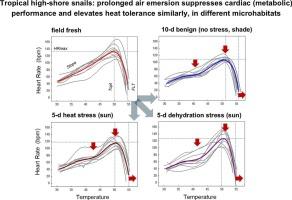一个能量难题:热带高岸腹足动物在逐渐暴露于空气中的能量状态和耐热性之间的矛盾关系。
IF 2.2
3区 生物学
Q4 BIOCHEMISTRY & MOLECULAR BIOLOGY
Comparative Biochemistry and Physiology A-Molecular & Integrative Physiology
Pub Date : 2025-08-11
DOI:10.1016/j.cbpa.2025.111917
引用次数: 0
摘要
高岸潮间带腹足类动物在空气回归过程中经历了高能量的热脱水应激条件,这与它们的垂直位置和生境异质性有关。同时,由于长时间不活动,这些腹足类动物在休息时被迫下调代谢,以限制脱水,并确保在食物(能量)摄入受限的情况下保持能量稳态。我们通过研究热带高海岸蜗牛(Planaxis sulcatus)在渐进空气浮现过程中代谢抑制的时间模式以及代谢抑制对热量的影响来研究这个明显的难题。我们比较了预先暴露于不同空气暴露期(野外新鲜,5天和10天)和不同程度的脱水和热应激的蜗牛的心脏热性能(代谢性能的代表),模拟自然阳光或阴凉的休息栖息地。与早期空气暴露相比,在良性(阴影)条件下的长时间休息抑制了心脏热性能和热耐受性的提高,这些反应大多不受脱水或热应激的影响。心脏(能量)抑制最初在个体中具有暂时性的特异性,随着空气再现时间的延长而变得更加均匀。重新分析的数据比较了不同处理下较高和较低的代谢(能量)状态,结果表明,能量较低的蜗牛具有更强的耐热性。同时需要支持能量要求高的保护性耐热性和能量守恒的代谢抑制,这一明显的能量难题可以用一个早期的、高能量要求的准备阶段来解释,这个阶段使蜗牛在冬眠期间变硬,而不考虑休息栖息地的条件。我们的代谢时间模式为高岸蜗牛的分子和细胞研究提供了一个极好的框架。本文章由计算机程序翻译,如有差异,请以英文原文为准。

An energetic conundrum: contradictory relationship between energetic state and heat tolerance during progressive air exposure in a tropical high-shore gastropod
High-shore intertidal gastropods experience energy-demanding thermo-dehydrative stressful conditions during air emersion, related to their vertical position and the habitat heterogeneity. Simultaneously, these gastropods are forced to downregulate metabolism when resting in air to limit dehydration and ensure energetic homeostasis under conditions of constrained food (energy) intake, due to prolonged inactivity. We investigated this apparent conundrum by studying the temporal patterning of metabolic depression and the influence of depressed metabolism on heat tolerance of the tropical high-shore snail, Planaxis sulcatus, during progressive air emersion. We compared cardiac thermal performance (a proxy for metabolic performance) of snails pre-exposed to different periods of air emersion (field fresh, 5 d and 10 d) and different levels of dehydration and heat stress, mimicking naturally sunned or shaded resting habitats. Compared to early air emersion, long resting periods under benign (shaded) conditions suppressed cardiac thermal performance and elevated heat tolerance, responses mostly not modified by dehydration or heat stress. Cardiac (energetic) suppression was temporally idiosyncratic among individuals, becoming more uniform with longer air emersion. Reanalyzed data comparing higher and lower metabolic (energetic) states across the treatments showed greater heat tolerance in lower-energetic snails. The apparent energetic conundrum of simultaneously needing to support energetically-demanding protective heat tolerance and energetically-conserving metabolic depression can be explained by an early highly energy-demanding preparatory stage, which hardens snails for the duration of aestivation, irrespective of the resting habitat conditions. Our observed temporal patterning of metabolism provides an excellent framework for molecular and cellular investigation of high-shore snails.
求助全文
通过发布文献求助,成功后即可免费获取论文全文。
去求助
来源期刊
CiteScore
5.00
自引率
4.30%
发文量
155
审稿时长
3 months
期刊介绍:
Part A: Molecular & Integrative Physiology of Comparative Biochemistry and Physiology. This journal covers molecular, cellular, integrative, and ecological physiology. Topics include bioenergetics, circulation, development, excretion, ion regulation, endocrinology, neurobiology, nutrition, respiration, and thermal biology. Study on regulatory mechanisms at any level of organization such as signal transduction and cellular interaction and control of behavior are also published.

 求助内容:
求助内容: 应助结果提醒方式:
应助结果提醒方式:


